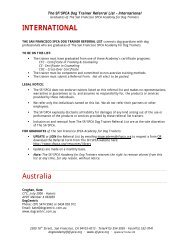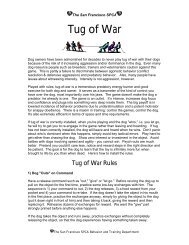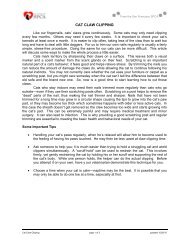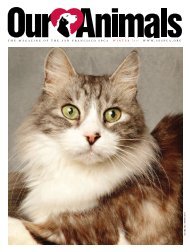Kitten Kindergarten - San Francisco SPCA
Kitten Kindergarten - San Francisco SPCA
Kitten Kindergarten - San Francisco SPCA
Create successful ePaper yourself
Turn your PDF publications into a flip-book with our unique Google optimized e-Paper software.
From the <strong>San</strong> <strong>Francisco</strong> <strong>SPCA</strong> Cat Behavior Program<br />
The “Elevator Butt”<br />
A misinterpretation of body language can also happen when<br />
you’re petting your cat’s lower back and he or she gets<br />
“elevator butt” (the cat pushes upward with his/her rear end<br />
while your petting near the tail). While your cat may seem to<br />
really enjoy this type of petting, this area is especially<br />
sensitive and likely to get the cat over-stimulated quickly. A<br />
recent study at the Massey University in New Zealand looked<br />
at cats’ reactions and tolerance levels according to certain<br />
body areas. The study found that cats preferred petting on<br />
their head and cheeks the most, with petting on their lower<br />
back being the least favorite spot. However, if you know your<br />
cat enjoys or tolerates this type of petting, it is okay to do it<br />
in moderate amounts.<br />
How to work with petting-induced aggression:<br />
The first thing to keep in mind is that it is very important to avoid getting the cat to the<br />
point where it is over stimulated or irritated. Even if you feel okay with the aggressive<br />
behavior (some people may think, "it’s OK if he bites, I don't mind”) you should remember<br />
it indicates that the cat is under stress. It also reinforces the biting habit and may<br />
increase aggressive incidents and/or intensity. This is probably due to the kitty feeling<br />
less trustful of handling. So, if you know the cat may get over stimulated after about 5<br />
minutes of petting, then only pet the cat for 4 minutes. Or, if you know the cat doesn’t like<br />
to be petted a certain way or in a particular area of the body, avoid doing so as much as<br />
possible. In time you can increase the duration of each petting session a little, and see if<br />
the cat’s tolerance level has changed.<br />
In many instances, if the cat has the freedom to get away from a<br />
situation that is over-stimulating him, he will choose to do that<br />
instead of aggress. The following will help in behavior modification:<br />
• Pair petting sessions with something pleasurable, such as treats.<br />
Always get your veterinarian’s approval if unsure as to whether<br />
a treat will be okay for your cat- or tell your vet that you need<br />
treats for behavior modification, and ask them to recommend<br />
some. Some popular treats are meat-based baby foods (make<br />
sure they are made of meat only, without onion or garlic, which<br />
are extremely toxic to cats), Bonito fish flakes, or Pounce.<br />
Petting-Induced Aggression page 3 of 5 updated 05/22/09<br />
\\Sf1-file-1\common\Adoption\Adoption\Forms and Procedures\Adoption Packet Handouts\Cat Adoption Packet\Petting Induced<br />
Aggression.doc
















